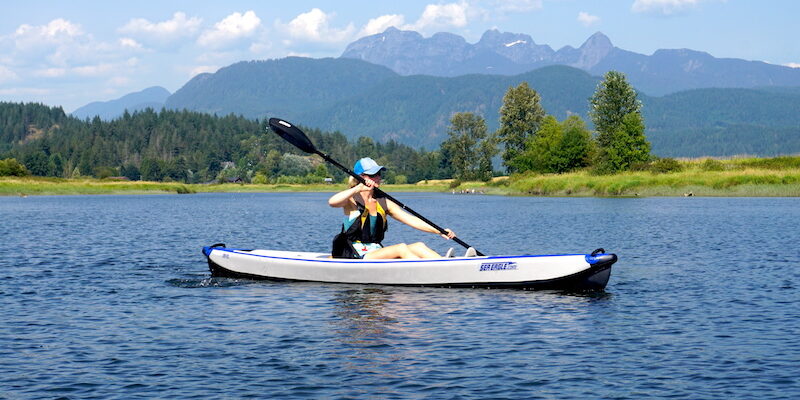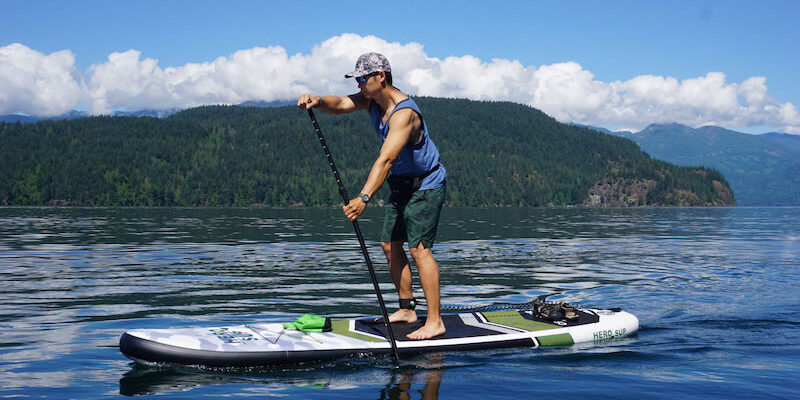As convenient and fun as an inflatable kayak is the one hassle is drying it out at the end of your kayak trip.
I have had a lot of practice with drying my inflatable kayak as well as cleaning it and have a few tips on how to make the process quick and simple.
Personally I like my kayak to be clean when I use it. Therefore I am fairly meticulous at removing all of the sand, gravel and rocks that get inside at the end of each use.
Mine gets particularly dirty because I usually have my dogs out paddling with me.
It only takes me a few minutes to clean out any debris and towel dry the kayak so that it is dry enough to deflate, roll up and store away in the kayak bag.
Drying Your Inflatable Kayak
If you have the time and it is a sunny day then leave your kayak sitting out in the sun for a short while to dry the surface.
If you don’t have the time to sit around and relax for a bit then you can get to work right away.
I always bring two towels with me and leave them in the car while I am kayaking. I usually need the both of them to get my inflatable kayak completely dry.
Begin removing the seats and bags from your kayak and then dry the outer surfaces with the towels while the kayak is still inflated.
Most inflatable kayaks dry out real easy so this process goes pretty quick.
From there deflate the floor and then tip your kayak sideways or upside down to drain out any excess water that has gathered inside the kayak. Use the towels to soak up any water that is left behind.
While doing this you can also use the towels to clear out any debris within the kayak such as sand, rocks or gravel.
Don’t worry if you can’t get all of the sand and gravel out. As long as the kayak is dry you won’t have any problems.
Then deflate the rest of the kayak and continue to use the towels to soak up any excess moisture. This whole process takes very little time and if you are not too fussy you can probably have it done in a matter of two minutes.
When you roll your deflated inflatable kayak up use the towel to dry off the underneath of the kayak as you are rolling it.
How Dry Does it Need to Be?
If you are using your inflatable kayak at least once a week then you don’t have to be too paranoid about leaving a little moisture.
As long as you get the majority of the water out of the kayak you will be fine.
However if you are kayaking less often it will be more important to have your kayak dried out as much as possible in order to avoid mold and mildew buildup (especially if you live in a humid environment).
Storing your Inflatable Kayak
For several months of the year the weather in my town is extremely cold and my inflatable kayak does not get used.
So just before winter sets in I tend to do a major clean out of my kayak before it gets stored away for the cold season.
At this point you can spend a little more time on your inflatable kayak and make sure that you have not only dried it out with a towel but have allowed it to sit in open air to for a little while to make sure it is really dry.
This is normally when I will use my kayak soap and really give it a good clean as well.
Quick & Easy
I promise that after you have dried your inflatable kayak out a couple of times you will become an old pro and find that you can whip through this process really fast.
Keep in mind that the dirt, sand and rocks that will undoubtedly gather inside the kayak are not a problem.
The water and moisture is the important part to dry out so that you don’t end up with mold and mildew.
Next Article: Is Kayak Therapy A Real Thing?


Would a blow dryer work to dry the inside of the bladders? Maybe alternating with the cool setting?
I’ve never tried it but I would think it should help. I’d definitely alternate with the cool setting though.
Thanks for the advice on here.
However I have a sevylor ottawa and cannot for the life of me dry it completely for storage.
Water gets inside the kayak skin and the entire inside of the boat skin is wet as are the bladders.
Openings for accessing the bladders are fairly small zippers, you cannot unzip the outer skin and turn it inside out, so it remains damp inside.
I have searched all over the net and found advice such as you give above, but this does not address internal moisture within the boat. It is just not accessible by hand to dry with towels, and even it it were there would still be residual damp which would mould.
Any thoughts?
Thanks
Paul
That’s a tough one. I find the kayaks with the zippered bladders hard to dry as well. It’s not the best setup and I think a downfall with some of the sevylor models. Wish I had some brilliant advice to give you but I don’t know any tricks for that unfortunately. Sorry I couldn’t help more!
I’ve just pulled out the floor bladder to try to dry out that section. It’s collected quite a lot of water. Have you found an effective way yet?
Hi I’ve bought the Ottowa too and find the exact same problem, it’s a bit of a nightmare. I’ve had to stretch my arm as far into the small zippered compartments as I could reach with a towel which took ages as I had to do this for 5 zips. Any advice from anyone greatly appreciated.
Thanks, John
I’ve thought of using a ski boot dryer for the bladders, such as DryGuy Travel Boot Dryer… they are only $40. Will try it this spring. I have a couple of inflatables and have the same issues, I’m pretty sure if someone was industrious there is definitely a market for this.
Hi
Lots of great advice on your site.
I am onto my fourth kayak, having been given a Pathfinder inflatable by a friend who purchased it and then decided kayaking wasn’t for him after just two times on the water.
Because of poor storage there is small amount of what appears to be mould.
What is the best way of getting rid of this? I have tried warm water and soap.
Also, during the winter how should an inflatable be stored —inflated or packed away?
Hi John, That’s a good question. It can be tricky because you don’t want to use a product that is going to damage the material or stitching on the kayak. I’ve never actually had to try and remove mold from my kayaks so I can’t speak from personal experience. However from what I’ve read the Mr. Clean Magic Eraser’s work quite well. I find them very toxic so I’m not a huge fan but they are recommended for the job. A more natural method is with a mixture of baking soda and vinegar. You will have to let the mixture sit on the mold for awhile then gently scrub it with a soft-bristled brush. Rinse well after then fully dry with a towel. I would personally try the baking soda and vinegar mixture first, it makes me nervous using any toxic cleaners on the boat material. Other than that I know some boating stores – especially those that sell zodiacs and inflatable boats will sell a natural cleaner for mold and mildew. When storing away for the winter, I normally do a really good clean while the kayak is inflated and then dry it thoroughly with a towel. If you can, leave it out for a couple hours after cleaning and drying just to let any additional moisture dry up. Then I roll it up and pack it away in it’s carry bag. Store it somewhere dry and you should have no mold issues. Good luck!
Hi, my wife and i just bought a 385ft and found your review very helpful. Had it out for the 1st time today. Lake Ontario was a bit choppy so we just went around in Ashbridges bay to get the feel of the boat and love it. In regard to drying the kayak, do you take the floor out while drying?
You have a great website with great information.
Rick
Hi Rick, Glad to hear you are enjoying the 385ft! I usually just try to lift the floor part way up and dry underneath it with my towel. If you are going to have the kayak out often you don’t have to worry about being too picky. However if the kayak is going to be stored away for awhile I will normally remove the floor and make sure it’s completely dry.